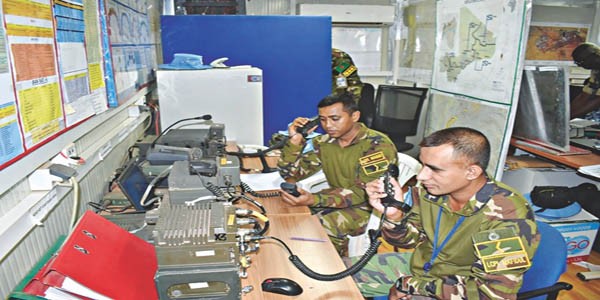Video Tele-Conference in BD Army
Introduction:
1. Video Tele-Conference – A Video Tele-conference (VTC) is a live, visual connection between two or more people residing in separate locations for the purpose of communication. There are many benefits; video calling with several participants, reduction of long distance travel, binding mobile workers, distance learning, etcetera. Bangladesh (BD) Army has started taking benefits out of VTC from 2013. At this backdrop, in this paper, various type of VTC setup and its functionality is discussed. Finally, present trend and future involvement of VTC in BD Army is focused upon.
Different Types of Video Conferencing
2. Video conferencing is either point-to-point for participants .n 2 different locations or multi-point for 3 or more locations.
a. Point-to-Point Video Conferencing. Point to point video conferencing connects two different points anywhere, for example, conference room of 00 Dte and conference room of BANBAT, Mali,
b. Multi-Point Video Conferencing. Video conferences among three or more remote locations can be either centralized or decentralized:
(1) Centralized Mufti-Point Video Conferencing. To execute a multi-point conference, in some cases a software or Hardware Bridge interconnects the endpoints, similar to an audio conference call. A multi-point bridge, multi-point control unit or multipoint conferencing unit (MCU), either on a remote server or embedded in the video conferencing system, ties the locations together. It works as follows:
(a) All audio and video data flow through the MCU’s “central processing center”.
(b) The MCU then sends the information out to each location.
(c) Audio is transmitted and received simultaneously to all locations in full-duplex mode (everyone can talk and hear at the same time as with a live, in-person conversation).
(d)Video is broadcasted differently, depending upon the software and system complexity.
আরও পড়ুন >> স্বপ্নে বাড়ী ঘর দেখলে আপনার কি হতে পারে
Offer View >> স্যামসাং হ্যান্ডসেট কিনলেই রবি দিচ্ছে আকর্ষণীয় অফার
(2) Decentralized Multi-Point Video Conferencing. Some video conferencing systems are capable of multi-point conferencing without any MCU. Decentralized multi-point video conferencing, based on the H.323 standard, lets each location exchange video and audio directly with other locations. This approach can afford higher quality video and audio due to absence of a gatekeeper, as well as greater convenience (participants can make ad-hoc multi-point calls regardless of MCU availability). On the other hand, it requires increased network bandwidth, since every station transmits to every other station directly.
Functions of Video Conferencing System Components
3. The core of a video conferencing system consists of elements that enable the capture and transfer of video images and audio
sounds. These elements are:
a. Video input – 2 or more video cameras or web cams.
b. Audio input – microphones either centrally located or on individuals.
c. Video output – computer screen, television and/or projector.
d. Audio output – professional speakers, headphones or laptop/computer speakers.
e. Codec – hardware or software-based coder-decoder technology that compresses analog video and audio data into digital packets and decompresses the data on the receiving end.
f. Echo cancellation software – diminishes audio delays to enable real-time conversation.
g. Network for data transfer-today most video conferencing is transmitted over a high-speed broadband Internet connection, using similar technology as VoIP (Voice over Internet Protocol) but LAN and occasionally ISDN connections are also used.
Present Trend of Video Tele-Conference
4. Since 2013, BD Army has started using VTC in various occasions. Initially 42 user stations were purchased which are located in various garrison auditoriums and other important places. Procurement for a few more is in the process. We can also use software based user stations. We are in possession of one MCU, located in AHQ Sigcen, which is used for Centralized Multi-Point Video Conferencing. VTC uses Army Wan as backbone.
5. We are using VTC for various events. Important events are listed below:
a. Broadcasting of AHQ project study. . –
b. Formation commanders’ conference.
c. Training conference of MT directorate with formation HQs.
d. Operational conference of 00 directorate with contingent HQs deployed in UN missions.
e. Distance learning program of STC&S for various corses.
Future Involvement of VTC in BD Army
6. There can be numerus future involvement of VTC. Ttie following are few important involvements:
a. Supporting Army in quicK aecis cr CAS ~s. :a a:r;e’e~:e~-r~a: r ::—a^-ae”
b. Transferring of various conferences to online:
(1) Annual CO/OC’s conferences held in various Records.
(2) Morning Brief of CO with various OCs; for example- CO, Signal battalion can ask OC, Brigade Signal Companies to join morning brief over VTC.
c. Distance learning program as follows:
(1) Military Science Course of Army Staff Course,
(2) Pre-course of various courses, eg. OWC, JC&SC etcetera.
(3) M.Sc/ Post graduate program under BUP/MIST.
d.Distance monitoring of online examinations.
Drawbacks
7.It is not always possible to get everyone in the same room, but it can be done virtually using video conferencing. There are however some disadvantages. No matter how good the equipment is, it will never be as good as physically being in the same room with someone. For example, people miss out on the visual clues provided by other people’s body language, which can sometimes be more revealing than what they are actually saying.
Conclusion
8. Video Tele-Conference – VTC has enabled video calling with several participants, reduced long distance travel. It helps important decisions to be taken quickly. It has bind mobile students, promoted distance learning. A soldier can educate himself being posted in a remote location. We should derive maximum benefit out of this technology.
শরীয়ত ও তরিকতের মৌলিক পার্থক্য এবং সম্পর্ক
নামাজ বিশুদ্ধ হওয়ার পূর্বশর্ত
 আমি বাংলার কথা বলি
আমি বাংলার কথা বলি



